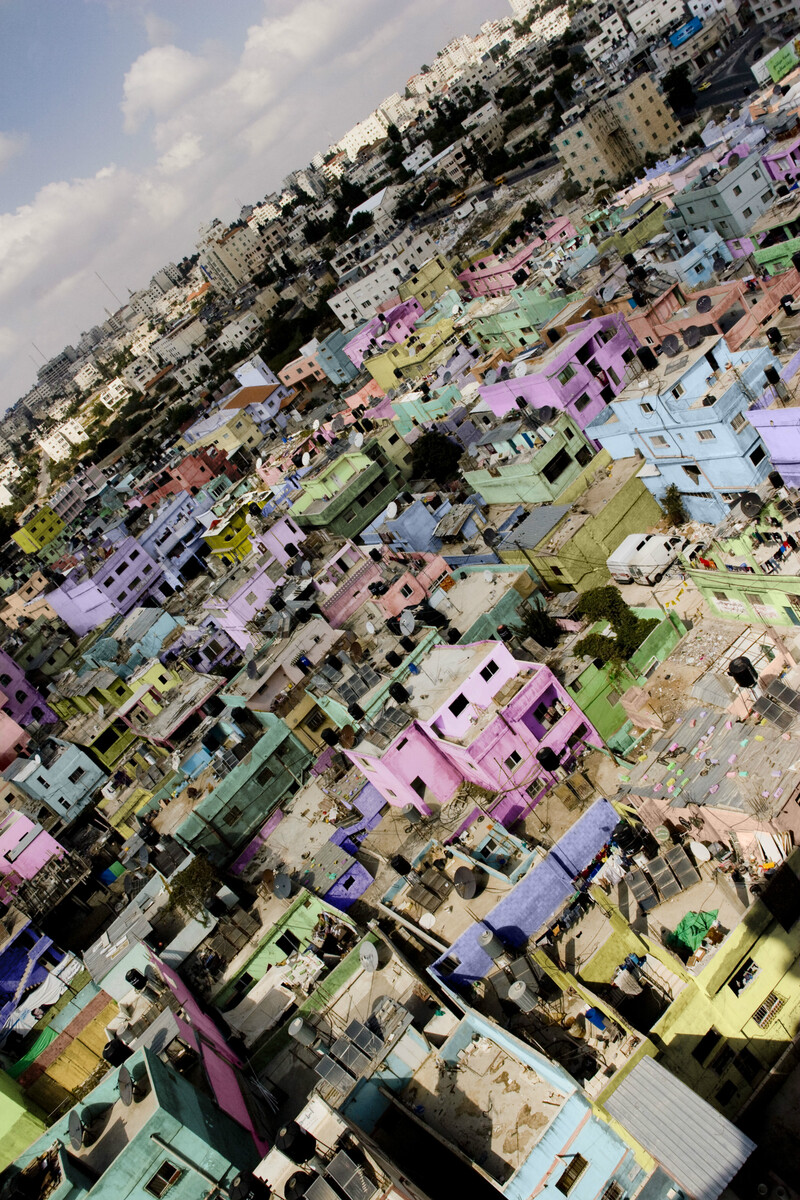The Electronic Intifada Sydney 16 October 2012

Colour Correction, Camp Series #3, 2007. C-type print, 100 x 66 cm.
Strikingly, almost all of the exhibited work is in some way an appropriation of existing images and scenarios, from the Mona Lisa to YouTube suicide bomber videos to real estate advertising. The artists have decided that the best way to communicate the Palestinian struggle to a comfortable Western audience is to provide images which are immediately recognizable to the Western eye, and then dislocate the viewer into an understanding of the Palestinians’ own surreal oppression.
The first image encountered at the front of the gallery, in an Australian city obsessed with house values, looks exactly like an estate agent’s window with dozens of properties for sale. But the buildings and land pictured in Taysir Batniji’s GH0809 (2010) are all in Gaza and were all destroyed by Israel in Operation Cast Lead, the three-week attack in the winter of 2008-2009.
Does the representation of these material victims of Israeli destruction indicate simply the absurdity of envisaging Gaza as a space where a house can be described as “three bedrooms, two bathrooms, stunning ocean views,” or does it represent a dreamed aspiration of what Gaza could be? Either way, the installation is challenging and problematic, and rendered profoundly human by the one deviation from the standard real estate text; the concluding phrase stating “inhabitants: five families (23 people).”
Pastiche
This materiality of structures is an understandably recurrent theme for a people whose homes are constantly threatened with demolition and whose land is dominated by a concrete wall. For me, the most powerful work on show is Batniji’s wall of black and white images: a pastiche of the beautiful industrial photography of German artists Bernd and Hilla Becher. Whereas the Bechers’ work is an attempt to re-conceive and create a virtual taxonomy of such structures as mineheads and water towers — stripping the structures down to specimens and aesthetic objects — the photographs in Batniji’s Watchtowers (2008) completely invert the Bechers’ detachment and force the viewer to engage with what the structures actually mean. What is the significance of Israeli checkpoints and towers to the people who must live with them?
The danger involved in taking these photos and the subsequent technical flaws in the images are a subtle thrust at the simple ease of the aesthetically preoccupied photographer in the West.
The thoughtful curating of the show by Chrisoula Lionis is demonstrated by the heightened impact of this monochrome work when placed opposite Yazan Khalili’s carnivalesque aerial images of a refugee camp (Color Correction, 2007). But it is when we move into the video work in the exhibition that the human element really takes over and the show makes its most direct statements about the how the world perceives the Palestinian and how Palestinians see the world.
Indictment of bias
Jacqueline Reem Salloum’s short video Planet of the Arabs (2005) is a devastating indictment of Western portrayals of Arabs, specifically in American film and television. Initially entertaining, her montage depicts the ubiquitous demonization of Arabs in the West.
An understanding of the circumstances of the artist makes many of the works on show even more resonant, and nowhere more so than with the fake film posters and DVD covers created by brothers Tarzan and Arab. When their Gazawood (2008) was completed, the brothers hadn’t been able to leave Gaza and so had never even seen a film in a cinema. To choose cinematic images as a vehicle to critique the sequence of Israeli attacks on their homeland becomes a powerful example of the oppression and deprivation which their community experiences every day.
There is much more in this exhibition, and I can only encourage anyone in Sydney to take an hour to visit the gallery in the coming weeks.
Beyond the Last Sky is showing free at the Australian Centre for Photography, Sydney, until 18 November. Nick Shimmin is a freelance writer and editor living in Sydney who spent a short time in the West Bank in 2011.


